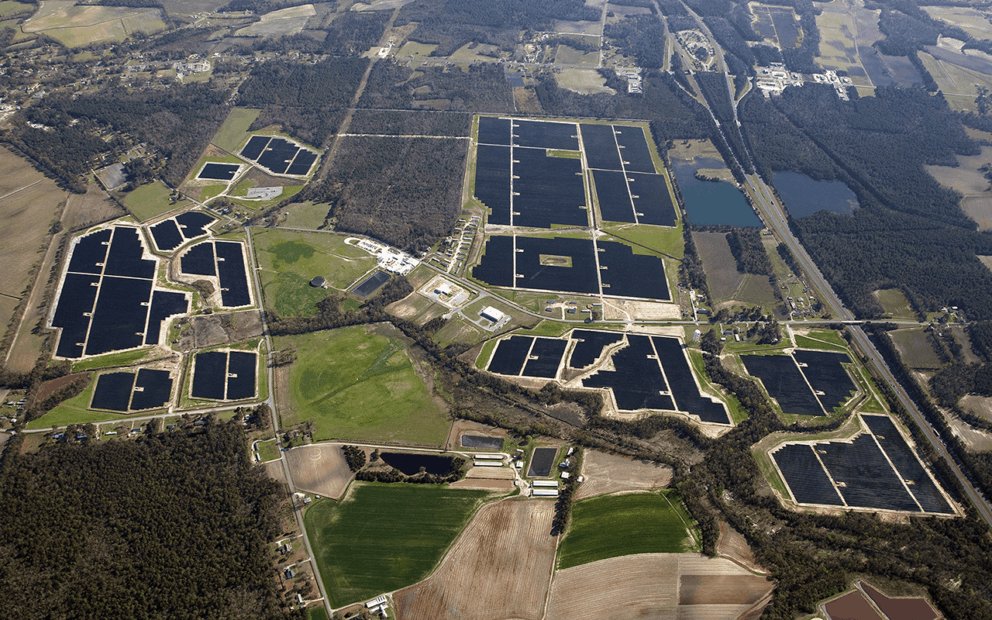
Aerial view of Strata Solar PV array in Warsaw, NC
Researchers in the FREEDM Systems Center led by NC State have received a $3.1 million research award from the U.S. Department of Energy Solar Energy Technologies Office (SETO) to advance solar energy’s role in strengthening the resilience of the U.S. electricity grid. The project will develop a Photovoltaic (PV) Analysis and Response Support (PARS) platform to provide real-time situational awareness and optimal response plan selection for electric utilities.
Grid management is becoming more complex with the addition of distributed renewable energy resources, and electric utilities require new tools to optimize a more complex system. In addition, extreme weather events and malicious cyber attacks are becoming more frequent. PARS will allow hybrid PV systems to operate similarly to conventional generation resources in terms of visibility, dispatchability, security and reliability. A team of researchers and faculty members from the FREEDM Systems Center, an NSF Engineering Research Center on the campus of NC State, will partner with the NC Cleantech Center, Pacific Northwest Laboratory, OPAL-RT Corporation, Strata Solar, New York Power Authority, Electricities of North Carolina, the City of Wilson — Wilson Energy and Roanoke Electric Cooperative to develop grid management tools to enhance power system resilience.
“PARS can be used to develop optimal response plans for hybrid PV systems located at the transmission or distribution levels,” says Dr. Ning Lu, principal investigator for the project. “And when running off-line using historical data, it will be a planning tool to design and test PV-based grid support functions and perform cost-benefit studies.”
PARS will use a new approach to complex grid management by linking steady state and dynamic elements together and performing real-time simulations and faster-than-real-time simulations in the same environment. The platform will also incorporate PV systems at any level of the grid in both normal and emergency operating scenarios.
The team will develop and deploy several tools on the PARS platform, including:
- An operations modeling tool that will incorporate new grid support functions,
- A model parameterization tool to update power grid operation models,
- A real-time situational awareness tool,
- An optimal response tool that incorporates distributed energy resources like PV and customer storage, and
- A cost benefit tool for addressing the value proposition of the newly developed grid support functions.
Linking these tools creates a seamless interface for users with multiple benefits. Real-time situational awareness that includes prediction of future operation allows for early detection of anomalous behavior like that seen during a cyber attack. Optimal response selection allows utilities to include distributed resources to participate in grid restoration.
“The goal here is to give utility operators better insight into grid operations and optimize performance under normal and abnormal conditions,“ says Lu, an associate professor in NC State’s Department of Electrical and Computer Engineering (ECE) and part of the FREEDM team. “We’re excited to get started and believe our unique approach will address multiple problems utilities are facing today and lead to more PV systems connected to the grid.”
Lu’s research interests include load modeling and control, wide-area energy storage, renewable integration, predictive defense modeling of the smart grid, and climate change impacts on power grids. She previously worked at Pacific Northwest National Lab and Shenyang Electric Power Survey and Design Institute. She currently supervises FREEDM’s GridWrx Lab. Additional project team members include Dr. Mesut Baran, Dr. David Lubkeman and Dr. Wenyuan Tang, all faculty members in ECE.
About the Solar Energy Technologies Office
The U.S. Department of Energy Solar Energy Technologies Office supports early-stage research and development to improve the affordability, reliability, and performance of solar technologies on the grid. Learn more at energy.gov/solar-office.
